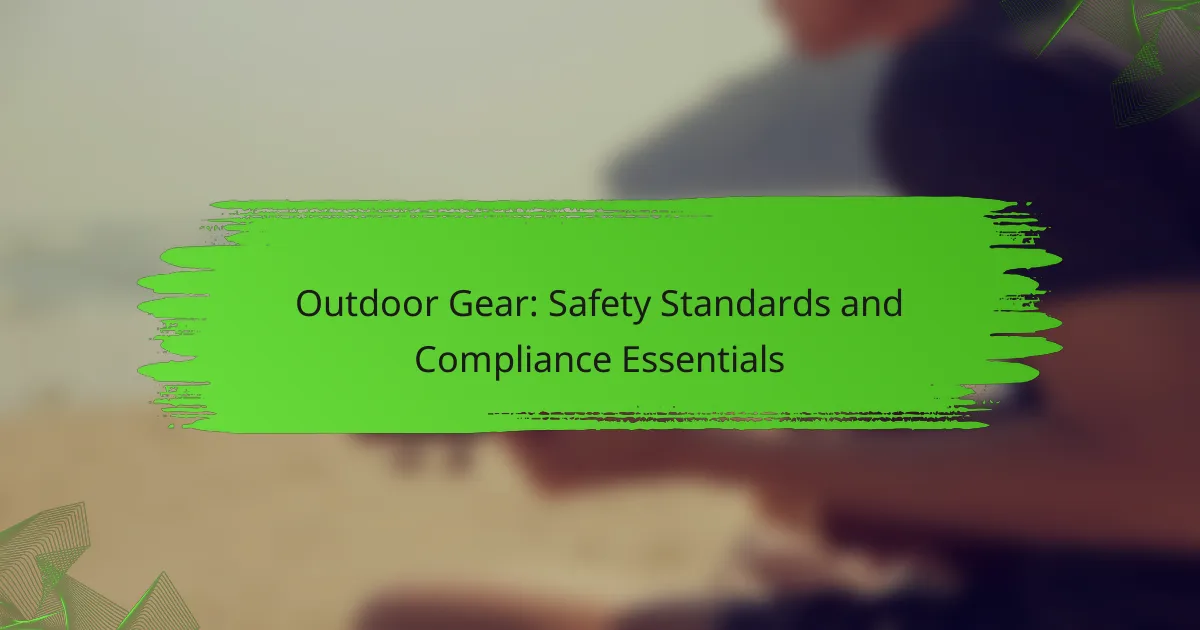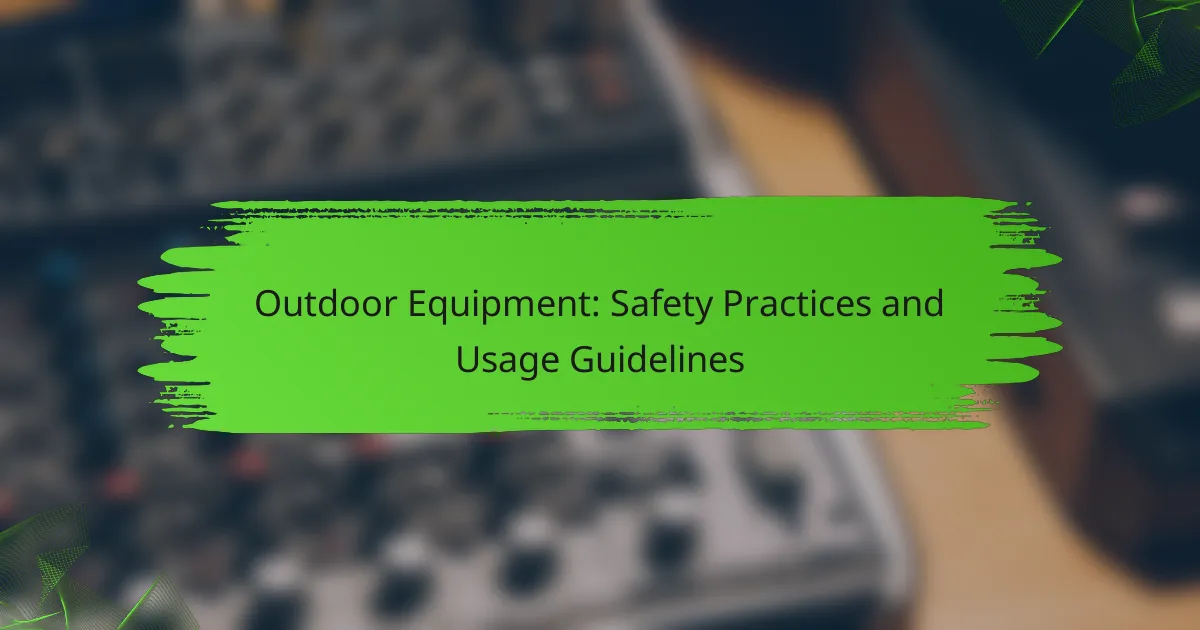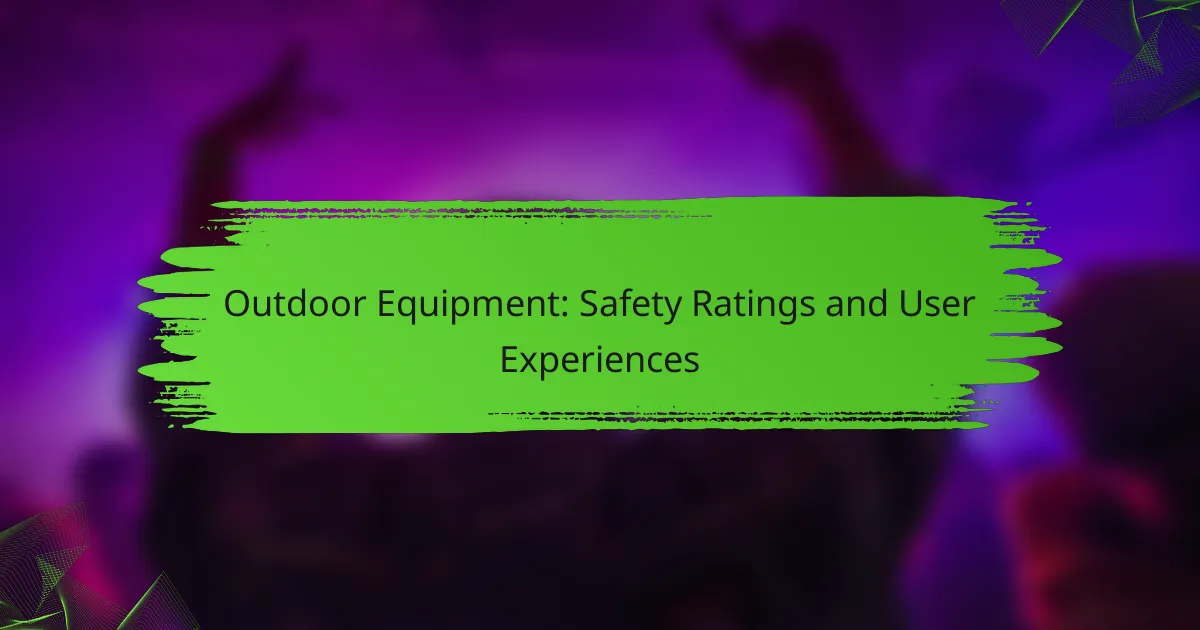Understanding safety standards for outdoor gear is essential for both consumers and manufacturers, as these standards ensure that products meet necessary performance and safety criteria. By adhering to rigorous testing and regulatory guidelines, manufacturers can guarantee compliance and protect users during outdoor activities. Non-compliance can result in serious risks, including legal issues and compromised consumer safety, making it crucial for the industry to prioritize these standards.
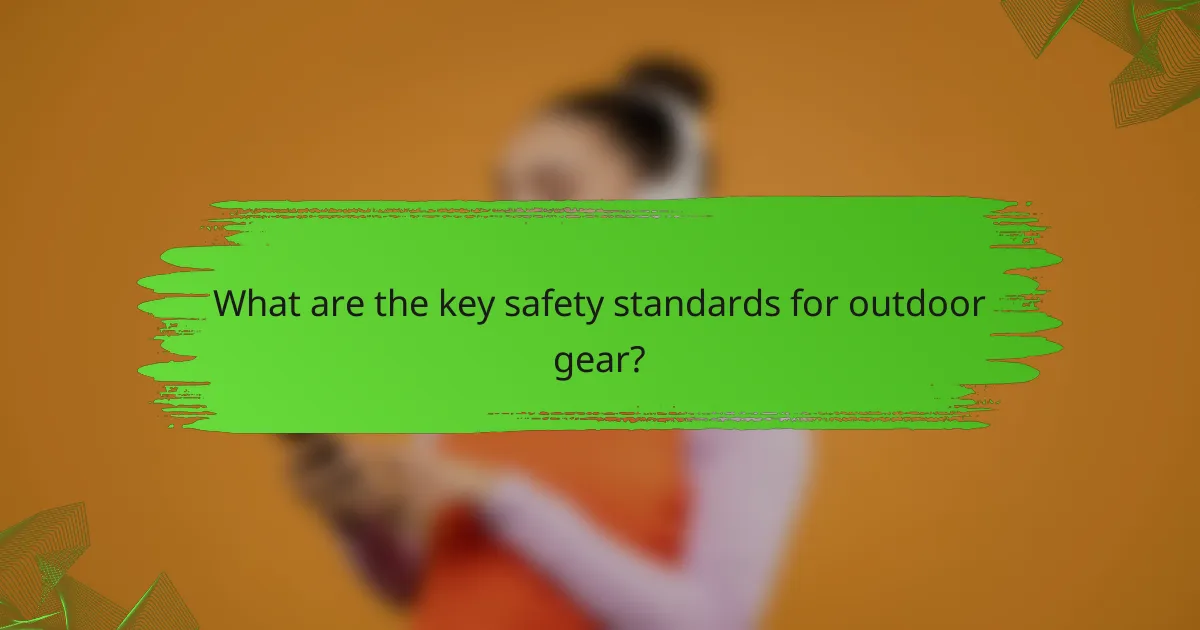
What are the key safety standards for outdoor gear?
Key safety standards for outdoor gear ensure that products meet specific performance and safety criteria, protecting users during outdoor activities. Familiarity with these standards helps consumers make informed choices and ensures compliance with regulations.
ASTM International standards
ASTM International develops and publishes voluntary consensus technical standards for a wide range of products, including outdoor gear. These standards cover various aspects, such as performance, safety, and testing methods, ensuring that gear like tents, backpacks, and footwear can withstand the rigors of outdoor use.
For example, ASTM F1975 outlines the performance requirements for camping tents, including wind resistance and water leakage tests. Adhering to these standards helps manufacturers produce reliable gear that meets consumer expectations.
ISO 9001 certification
ISO 9001 certification is a globally recognized standard for quality management systems. Companies that achieve this certification demonstrate their commitment to consistent quality and customer satisfaction in their outdoor gear production processes.
For outdoor gear manufacturers, ISO 9001 ensures that products are designed and produced under controlled conditions, reducing defects and enhancing reliability. Consumers can look for this certification as an indicator of a company’s dedication to quality.
EN 13537 sleeping bag standards
EN 13537 is a European standard that specifies testing methods for sleeping bags, focusing on thermal performance and safety. This standard provides temperature ratings, helping consumers choose the right sleeping bag for their intended use.
Under EN 13537, sleeping bags are tested for three temperature ratings: comfort, lower limit, and extreme. Understanding these ratings allows users to select bags suitable for specific weather conditions, enhancing safety and comfort during outdoor adventures.
UIAA climbing gear standards
The UIAA (International Climbing and Mountaineering Federation) establishes safety standards for climbing gear, including harnesses, ropes, and carabiners. These standards ensure that equipment can withstand the forces encountered during climbing activities.
For instance, UIAA standards require climbing ropes to pass rigorous strength tests, ensuring they can handle dynamic loads. When purchasing climbing gear, look for UIAA certification to ensure your equipment meets high safety standards, reducing the risk of accidents.
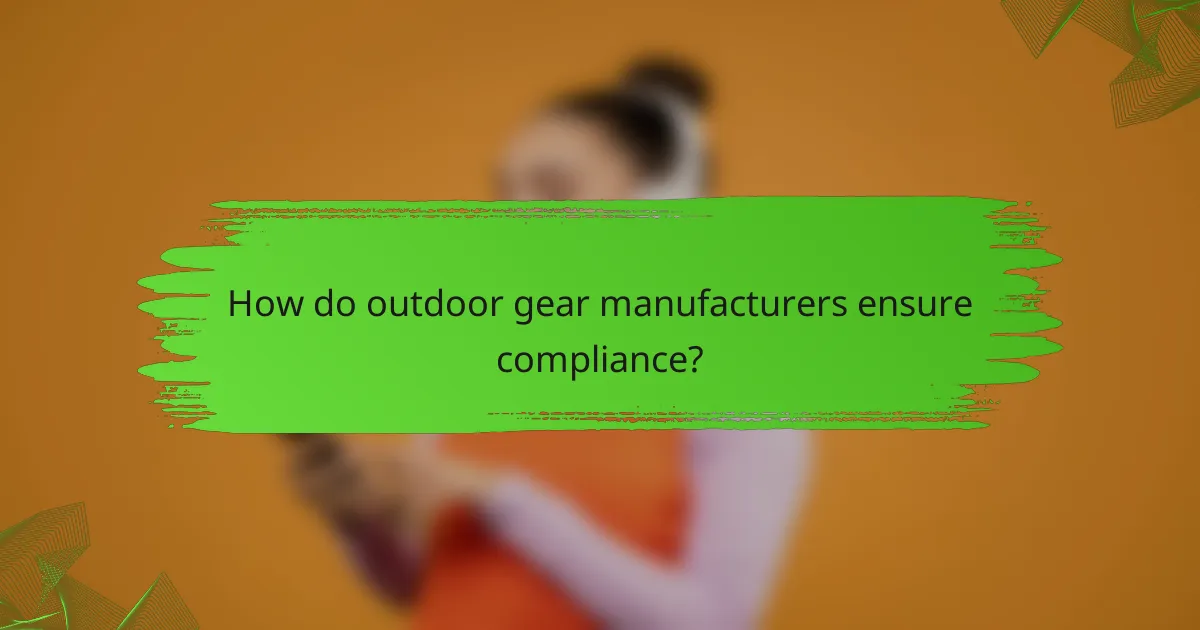
How do outdoor gear manufacturers ensure compliance?
Outdoor gear manufacturers ensure compliance through a combination of rigorous testing, adherence to regulatory guidelines, and robust quality control processes. These measures help guarantee that products meet safety standards and perform reliably in various conditions.
Regular testing and certification
Regular testing and certification are critical for outdoor gear manufacturers to validate the safety and performance of their products. Manufacturers often collaborate with accredited laboratories to conduct tests that simulate real-world conditions, ensuring that gear can withstand the rigors of outdoor use.
Common tests include durability assessments, water resistance evaluations, and impact resistance checks. Certification from recognized organizations, such as the American National Standards Institute (ANSI) or the European Committee for Standardization (CEN), provides consumers with confidence in the product’s safety and reliability.
Adherence to regulatory guidelines
Adherence to regulatory guidelines is essential for outdoor gear manufacturers to ensure compliance with safety standards. These guidelines vary by region and may include specific requirements for materials, design, and labeling. For example, in the European Union, outdoor gear must comply with the General Product Safety Directive.
Manufacturers must stay informed about the latest regulations and update their products accordingly. Regular audits and inspections can help ensure ongoing compliance and identify any areas needing improvement.
Quality control processes
Quality control processes are integral to maintaining compliance in outdoor gear manufacturing. These processes typically involve systematic checks at various stages of production, from raw material sourcing to final assembly. By implementing strict quality control measures, manufacturers can catch defects early and minimize the risk of non-compliance.
Common practices include visual inspections, functional testing, and batch sampling. Manufacturers may also employ statistical process control (SPC) techniques to monitor production consistency and ensure that products consistently meet safety standards.
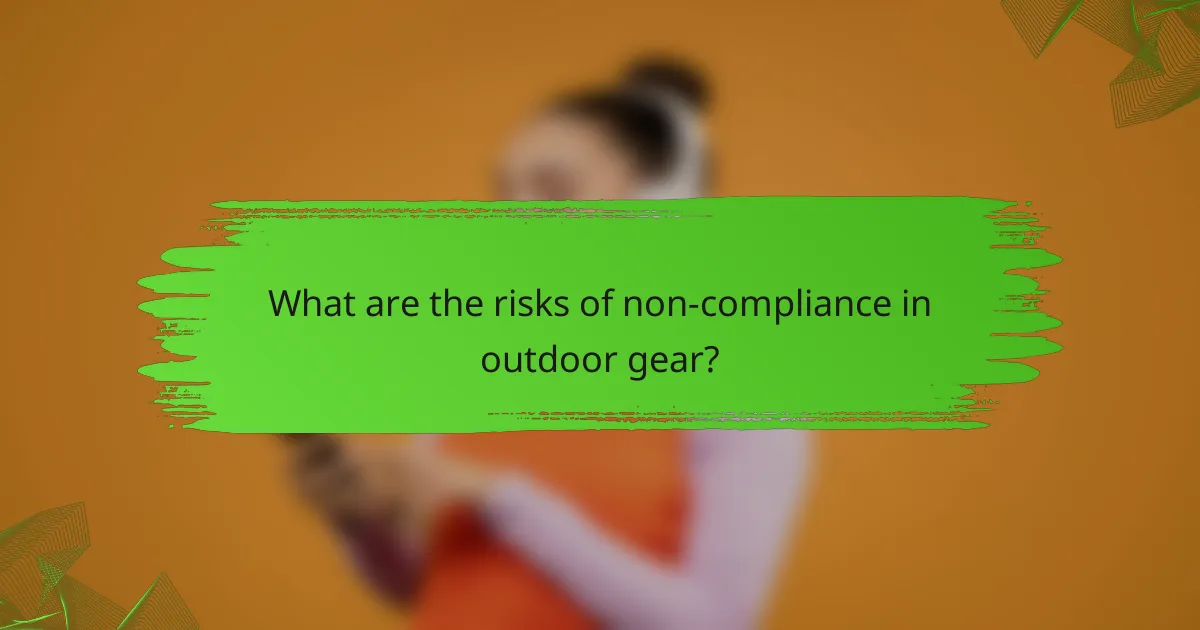
What are the risks of non-compliance in outdoor gear?
Non-compliance in outdoor gear can lead to significant risks, including legal repercussions, consumer safety issues, and damage to brand reputation. Manufacturers must adhere to safety standards to protect both their business and their customers.
Increased liability for manufacturers
Manufacturers face heightened liability when their products do not meet established safety standards. This can result in costly lawsuits, fines, and potential recalls, which can severely impact financial stability. For instance, if a tent collapses due to subpar materials, the manufacturer could be held accountable for injuries or damages.
To mitigate this risk, manufacturers should conduct thorough testing and ensure compliance with relevant regulations, such as those set by the American National Standards Institute (ANSI) or the International Organization for Standardization (ISO).
Potential harm to consumers
Non-compliance can lead to serious safety hazards for consumers, including injuries or fatalities. For example, outdoor gear like climbing harnesses or helmets that fail to meet safety standards may not provide adequate protection in emergencies. This places users at risk during outdoor activities.
Consumers should be aware of safety certifications when purchasing outdoor gear. Checking for labels indicating compliance with recognized standards can help ensure the gear is safe for use.
Loss of market trust
When outdoor gear manufacturers fail to comply with safety standards, they risk losing consumer trust. A single incident of non-compliance can tarnish a brand’s reputation, leading to decreased sales and customer loyalty. Brands that prioritize safety and transparency tend to build stronger relationships with their customers.
To regain trust, companies should openly communicate their commitment to safety, share compliance certifications, and take proactive steps to rectify any compliance issues. Engaging with customers through transparent practices can help rebuild confidence in the brand.
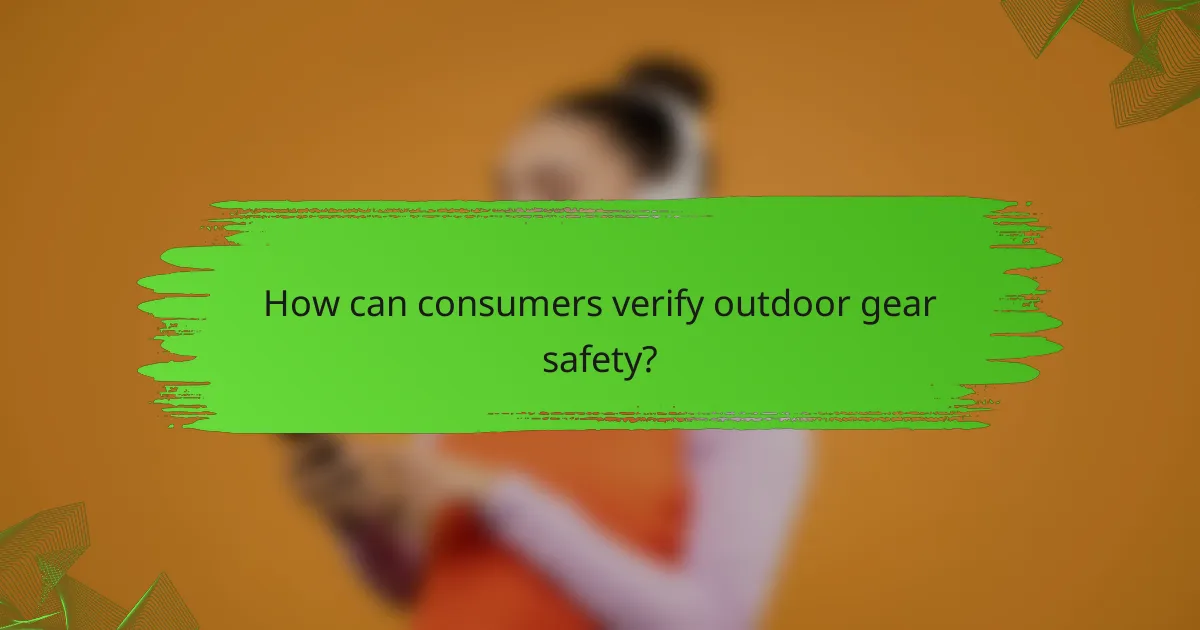
How can consumers verify outdoor gear safety?
Consumers can verify outdoor gear safety by checking for certification labels, researching brand reputation, and reading product reviews. These steps help ensure that the gear meets safety standards and is reliable for outdoor activities.
Checking for certification labels
Certification labels indicate that a product has undergone testing to meet specific safety standards. Look for labels from recognized organizations such as the American National Standards Institute (ANSI) or the International Organization for Standardization (ISO).
When examining labels, consider the type of gear and its intended use. For instance, climbing gear should meet UIAA (International Climbing and Mountaineering Federation) standards, while camping equipment may need to comply with different regulations.
Researching brand reputation
Brand reputation plays a crucial role in assessing outdoor gear safety. Established brands often have a history of compliance with safety standards and positive customer feedback. Investigate brands known for their commitment to quality and safety.
To gauge a brand’s reputation, check their website for safety certifications and any history of recalls. Additionally, look for brands that actively participate in industry safety initiatives or have partnerships with safety organizations.
Reading product reviews
Product reviews provide insights from other consumers about the safety and performance of outdoor gear. Look for reviews that specifically mention safety features and any issues encountered during use.
Focus on reviews from reputable sources or outdoor enthusiasts who have tested the gear in real-world conditions. Pay attention to recurring themes in reviews, such as durability and reliability, which can indicate how well the gear performs in safety-critical situations.
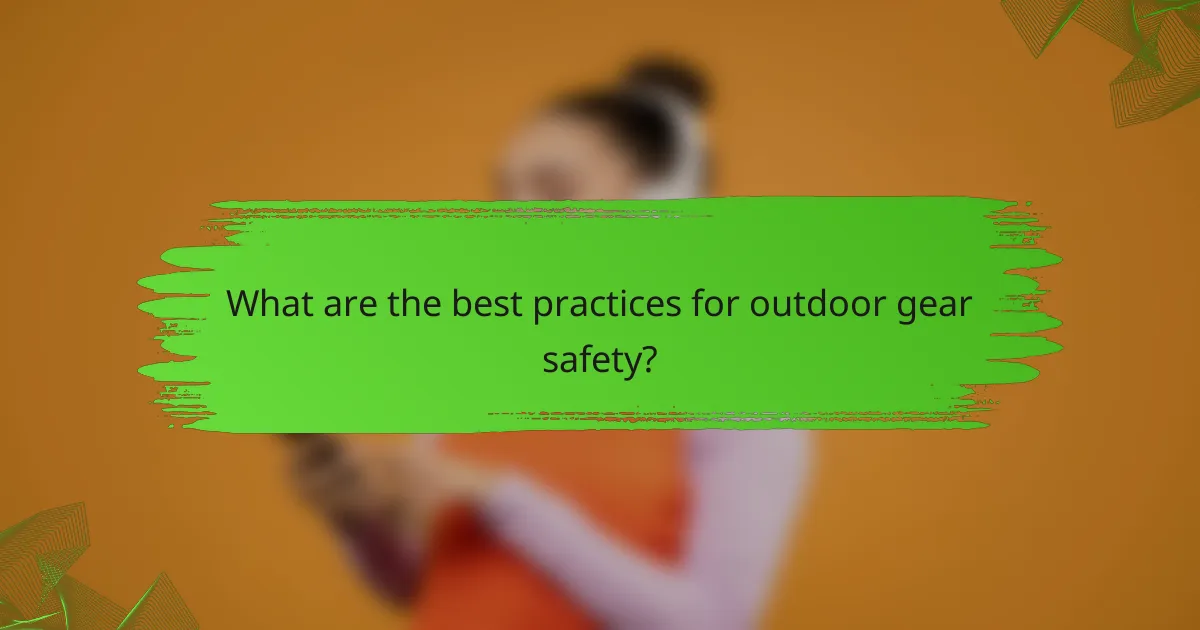
What are the best practices for outdoor gear safety?
Best practices for outdoor gear safety include regular maintenance, adherence to manufacturer guidelines, and staying updated on safety recalls. These practices help ensure that equipment functions correctly and reduces the risk of accidents during outdoor activities.
Regular maintenance and inspections
Regular maintenance and inspections are crucial for ensuring outdoor gear remains safe and functional. Check equipment for signs of wear, such as frayed straps or rusted components, and clean items according to the manufacturer’s recommendations.
Establish a routine inspection schedule, ideally before each use or season. This could include checking tents for leaks, testing climbing gear for integrity, and ensuring that safety features on equipment are operational.
Following manufacturer guidelines
Following manufacturer guidelines is essential for maintaining the safety and performance of outdoor gear. Each piece of equipment comes with specific instructions regarding usage, care, and limitations, which should be strictly adhered to.
For example, if a tent has a maximum wind rating, avoid using it in conditions that exceed this limit. Familiarize yourself with the gear’s specifications and ensure that you are using it within those parameters to prevent accidents.
Staying informed on safety recalls
Staying informed on safety recalls helps protect users from potentially dangerous equipment. Manufacturers and regulatory bodies often issue recalls for gear that may pose safety risks due to defects or failures.
Regularly check official websites or sign up for alerts from manufacturers to receive timely information about recalls. If a recall is announced, follow the provided instructions for returning or repairing the affected gear.
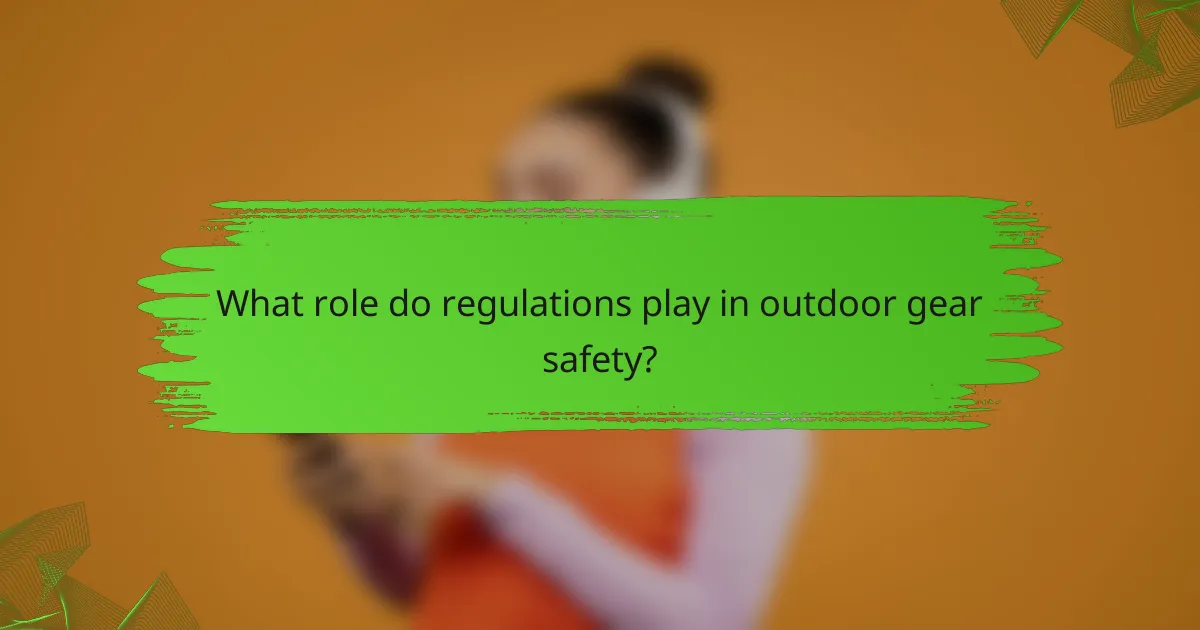
What role do regulations play in outdoor gear safety?
Regulations are essential in ensuring outdoor gear safety by establishing standards that products must meet to protect users. These rules help manufacturers create reliable equipment while providing consumers with assurance regarding the safety and quality of their purchases.
Establishing minimum safety requirements
Minimum safety requirements set the baseline for what is acceptable in outdoor gear, covering aspects like materials, construction, and performance. For example, climbing gear must meet specific strength and durability standards to prevent failures during use.
Regulatory bodies, such as the American National Standards Institute (ANSI) and the European Committee for Standardization (CEN), develop these standards. Compliance with these regulations helps manufacturers avoid liability issues and ensures that consumers receive safe products.
Guiding product development
Regulations significantly influence product development by providing a framework that guides design, testing, and manufacturing processes. Manufacturers often incorporate safety features based on these standards, such as reflective materials in outdoor clothing for visibility.
Incorporating regulatory guidelines early in the design phase can streamline the development process and reduce the risk of costly redesigns. Companies should regularly review and update their products to align with evolving safety standards and consumer expectations.
